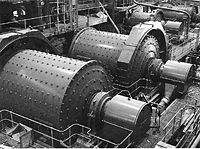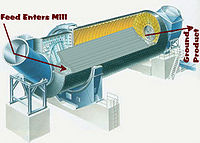Rod Mills
Rod Mills are similar with the Ball Mills xcept they use long rods for grinding media. The rods grind the ore by tumbling within the the mill, similar to the grinding balls in a ball mill. To prevent the conditions leading to rod charge tangling, the length to diameter ratio is maintained at 1.4 to 1.6. Rod mills accept feed up to about 50 mm (2 in.) and produce a product in the size range of 3000 to 270 mm (–4 to –35 mesh). Grinding action is by line contact between the rods extending the length of the mill. Rods tumble and spin in roughly parallel alignment simulating a series of roll crushers. This results in preferential grinding of coarse material and minimizes production of slimes.
Of the three main types of rod mill, overflow, end peripheral discharge, and center peripheral discharge only the overflow mill is in common usage. Wet grinding rod mills are normally used in the mineral processing industry. Dry grinding is used in some areas; however, it is confronted with problems and should be avoided except where absolutely necessary. Rod mills operate at lower speed than ball mills since the rods are rolled and not cascaded. For an equivalent grind, a rod mill uses less steel than a ball mill because of the lower speed and better contact between the media and ore. The rod charge must be maintained in good working condition, and broken and worn rods must be removed. Rod mills usually require greater operator attention. It is important that the rods stay essentially parallel to one another. If rods become misaligned, grinding action is lost and, more importantly, rod tangles occur. Maximum rod length is limited to about 6.1 m (20 ft). This in turn limits the length, diameter, and capacity of rod mills. The heavier rods acting upon the lifters and liners result in greater wear on the mill liners.
Rod mills normally carry 35 to 65% rod charge by volume. The limits on charge level are (1) keeping the feed end trunnion open so that feed will get into the mill, and (2) keeping the rod charge low so rods will not work their way into discharge openings where they can cause rod tangling.
Video

